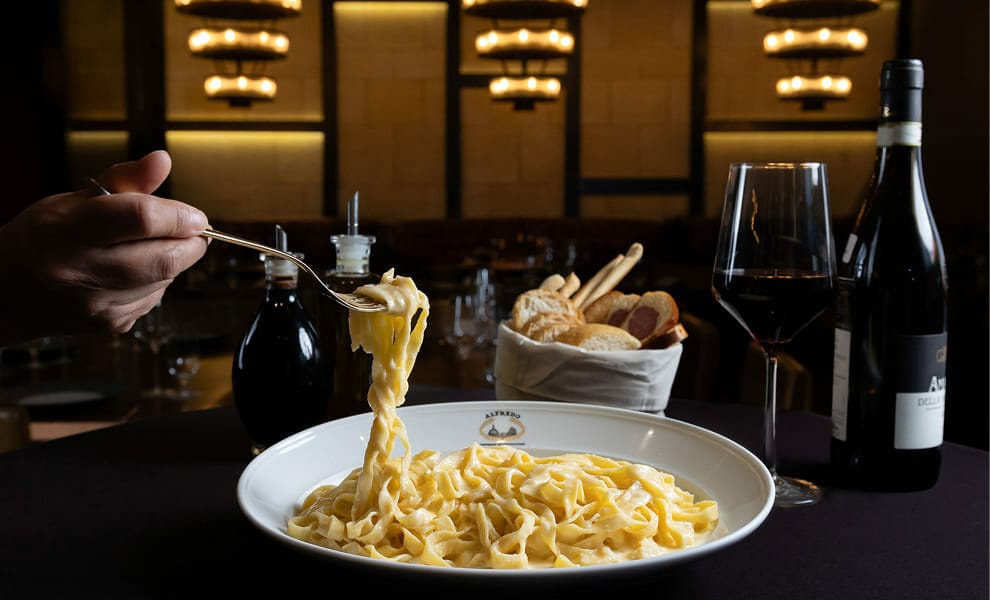The golden ribbons of fresh tagliatelle unfurl from the pasta machine like silk scarves catching morning light. Steam rises from a pot of simmering ragù, its rich aroma weaving through the kitchen air, whilst skilled hands dust flour across a marble counter where pillowy gnocchi rest in perfect rows. This is the daily ritual that turns simple ingredients – flour, eggs, water and time – into something that connects us to centuries of Italian tradition, right here in the heart of Mexico City.
Reviving Tradition – The Heartfelt Art of Fresh Pasta
In the bustling culinary scene of CDMX, Italian restaurants are reviving generational pasta-making techniques with religious devotion. The process begins with the careful selection of ingredients, but it’s the human touch that makes all the difference. Hand kneading develops the gluten structure that gives pasta its distinctive bite, whilst hand laminating creates the delicate texture that sets artisanal pasta apart from its machine-made counterparts.
Each step requires precision that becomes second nature through repetition. The dough must rest at the right temperature, be rolled to exact thickness and cut with steady hands that understand how fettuccine differs from pappardelle not just in width, but in the way it will hold sauce. These techniques, passed down through generations since the Renaissance when Florence and the Medici family popularised pasta-making, form a shared language amongst kitchen staff who speak fluent Italian through their fingertips.
The commitment to traditional methods extends to cooking technique as well. Achieving the perfect al dente texture – that slight resistance when bitten – requires timing that comes from experience rather than timers. It’s this attention to detail that distinguishes authentic Italian preparation from approximations, creating pasta that maintains its integrity when married with sauce.
A Delicious Tale in Every Bite
Fresh pasta serves as edible archaeology, each shape telling stories of its origins. Tagliatelle emerged from the kitchens of Emilia-Romagna, its flat ribbons designed to capture rich meat sauces, whilst ravioli parcels originated as a way to turn humble leftovers into elegant filled pasta that graced noble tables. The pasta traditions of Naples revolutionised how we think about combining tomatoes with wheat, creating foundations for countless beloved dishes.
When you twirl those golden strands around your fork, you’re participating in rituals that have connected families across Italy for centuries. From the robust flavours favoured in Rome to the refined techniques perfected in Florence, each pasta shape carries genetic memory of the regions that birthed them. Much like artisans who preserve cultural heritage through craft, pasta makers in Mexico City honour these traditions whilst adapting them for contemporary palates.
The Perfect Pair – Marrying Pastas and Wines
The alchemy of pairing Italian wines with fresh pasta elevates a simple meal into a complete sensory experience. When tagliatelle al ragù meets a robust Tuscan red, the wine’s tannins provide structure that balances the rich, slow-simmered sauce, whilst the pasta’s silky texture provides a perfect canvas for both flavours to shine.
Sofia settles into her corner table as the server presents options with practiced enthusiasm. ‘For the ravioli di ricotta e spinaci, might I suggest our Pinot Grigio from Alto Adige?’ The wine arrives first – crisp, with subtle fruit notes that won’t compete with the delicate filling. When the pasta appears, bright green spinach visible through translucent pasta walls, the first bite confirms the pairing’s wisdom. The wine’s acidity cuts through the ricotta’s richness whilst its mineral notes enhance the earthy spinach.
Gnocchi in gorgonzola sauce tells a different story entirely. The Italian sparkling wine that accompanies it provides effervescence that cleanses the palate between bites of the indulgent, cheese-laden dish. Expert sommeliers understand that successful pairings depend less on rigid rules than on understanding how flavours interact, creating harmony rather than competition on the palate.
A Table for All – Hospitality and Community
The atmosphere in Italy’s best pasta kitchens extends far beyond technical skill into the realm of genuine hospitality. Warm lighting creates intimacy, whilst the open kitchen design allows diners to witness the careful choreography of pasta preparation. The sound of bubbling water, the rhythmic chopping of herbs and the gentle conversation between staff creates a soundtrack that speaks of comfort and care.
Tables are set with intention – proper pasta bowls that allow for elegant twirling, wine glasses that enhance each vintage’s characteristics and utensils that feel substantial in the hand. The pacing of service acknowledges that pasta is meant to be savoured, not rushed, encouraging guests to linger over conversation and second glasses of wine. This mirrors the thoughtful approach to creating meaningful dining experiences that bring people together.
This approach to dining fosters genuine community. Neighbouring tables strike up conversations about wine selections, couples share tastes of different pasta preparations and solo diners find themselves chatting with servers who treat wine and pasta pairing as art worth discussing. The restaurant becomes a gathering place where the simple act of eating well creates connections between strangers.
Restaurants like Alfredo Di Roma have spent over two decades perfecting this balance between technical excellence and warm hospitality, understanding that the best pasta experiences happen when skill meets genuine care for guests’ comfort and enjoyment.
An Invitation to Simple Pleasures
Mexico City offers profound satisfaction in the simple ritual of fresh pasta preparation and consumption. Whether you’re discovering the silky pleasure of handmade pappardelle for the first time or returning to rediscover why gnocchi feels like edible comfort, these Italian traditions offer something increasingly rare: the opportunity to slow down and appreciate craftsmanship applied to everyday pleasure.
Much like the renewed appreciation for intimate dining experiences sweeping through Europe, Mexico City’s pasta scene invites you to experience these rituals yourself. Find a table where pasta is made with hands that understand tradition, where artisans blend Italian technique with local passion, and where wine pairings are suggested with knowledge born of genuine enthusiasm rather than rote memorisation.
Allow yourself the luxury of a meal where every element, from the flour dusting the pasta maker’s apron to the final drops of wine in your glass, has been considered with care. There’s rebellion in choosing to sit down to a properly made plate of fresh pasta, paired with wine that was selected specifically to make those flavours sing. Sometimes the most radical act is simply allowing yourself to enjoy something made well, slowly, with love.





